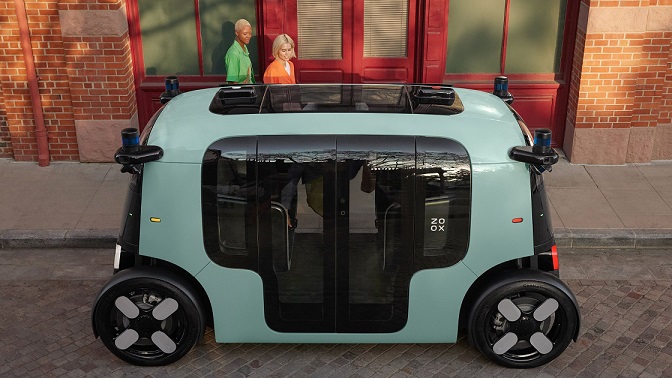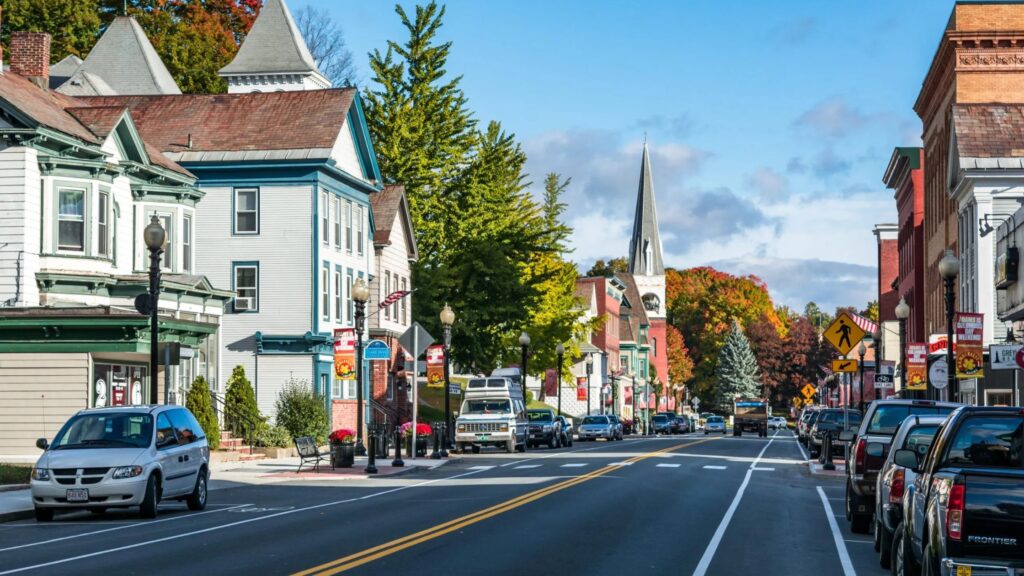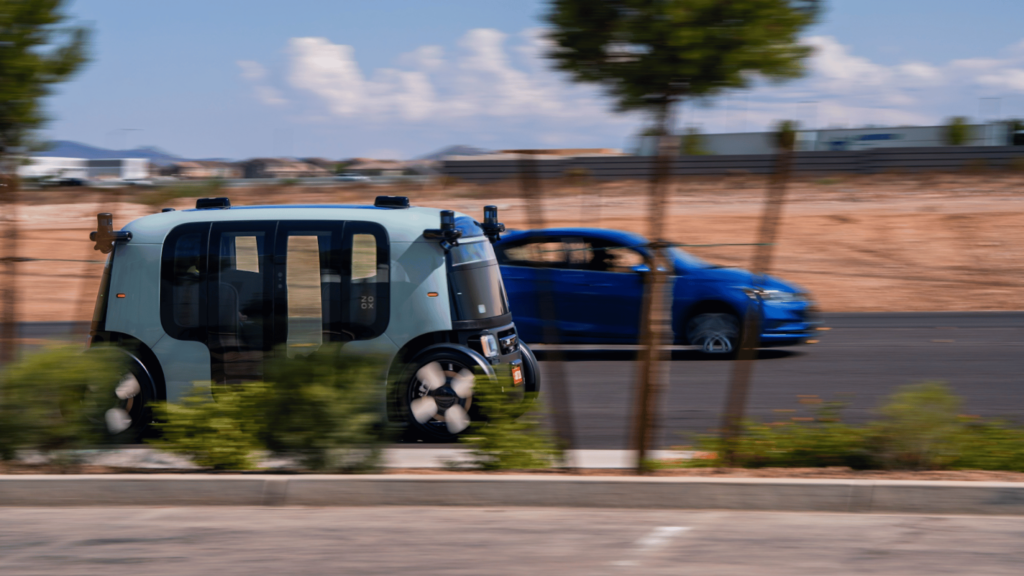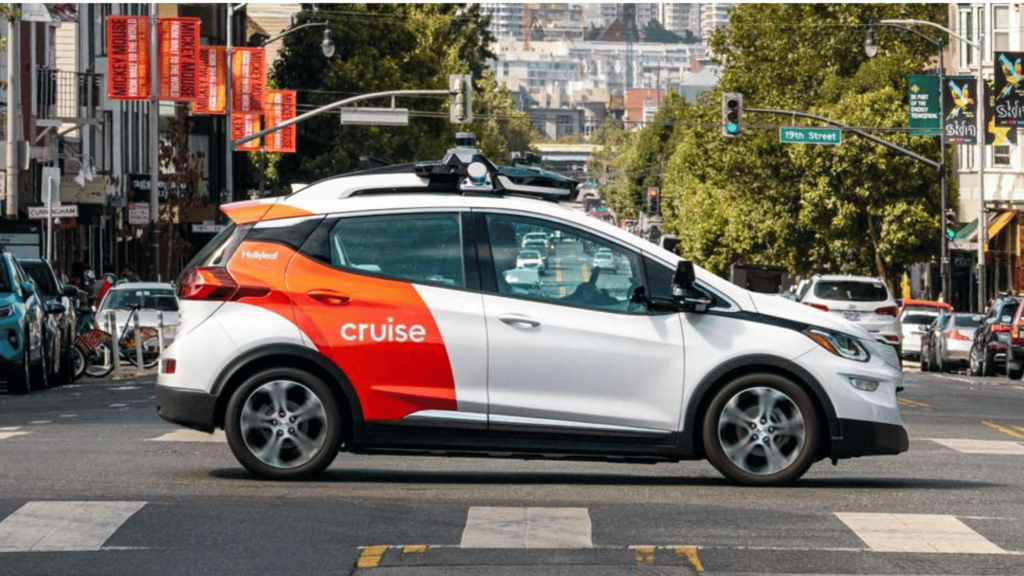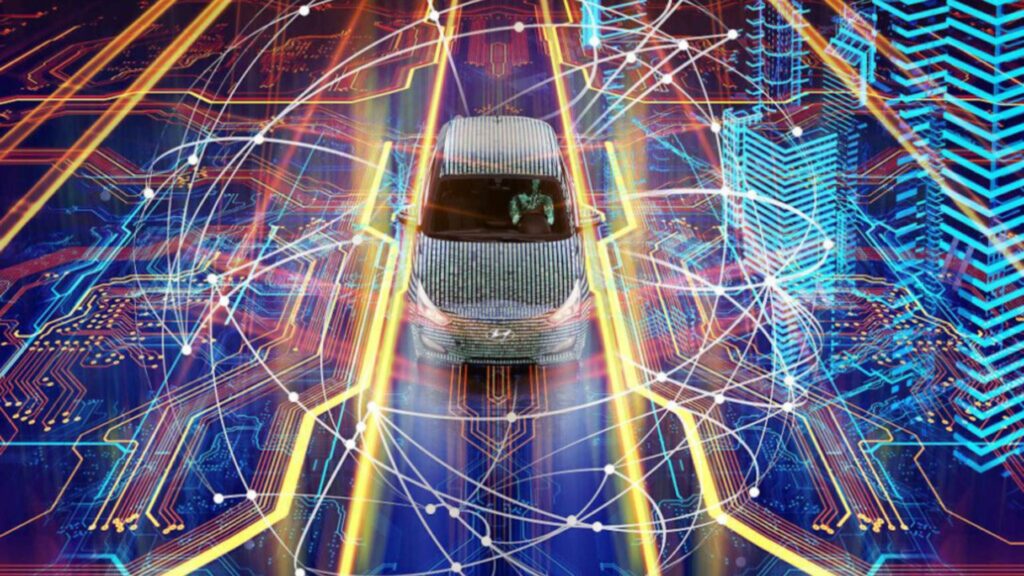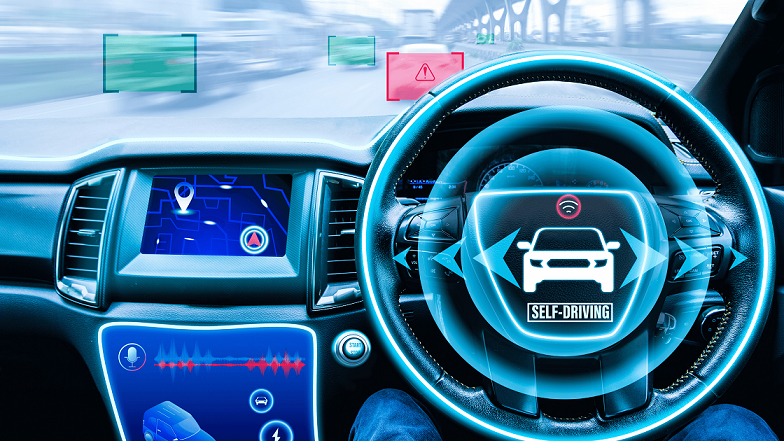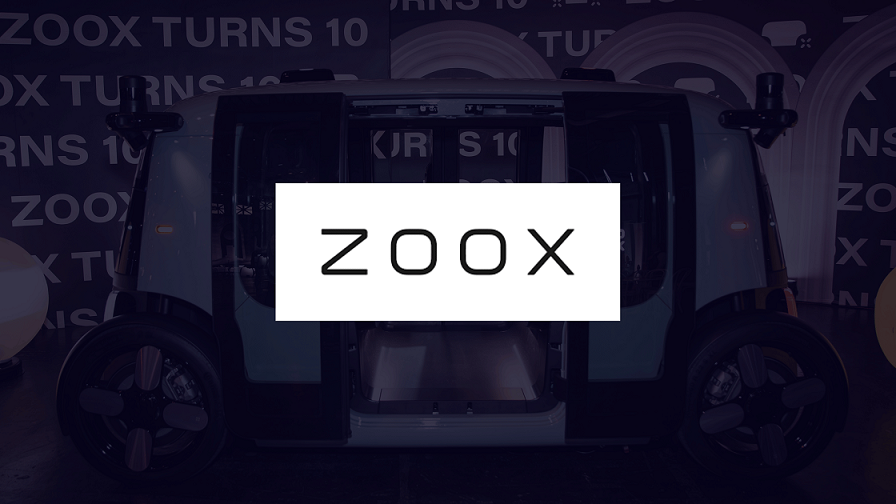Table of Contents
Zoox is now the first company in history to provide a fully autonomous ride-hailing service in a purpose-built robotaxi.
The Zoox robotaxi is a fully autonomous, all-electric ride-hailing vehicle. Unlike competitors who retrofit existing vehicles with self-driving technology, Zoox has designed something entirely different—a vehicle that was imagined, from the very beginning, to operate without a human driver. Zoox’s vehicle was designed from the ground up to be a driverless taxi (not a car with its steering wheel taken out), and the company has moved from lab demos to public rides — starting with Las Vegas.
This distinction heralds a fundamental shift in how we think about autonomous transportation.
From inception to 2025, Zoox has accumulated over 100 million fully autonomous miles. In 2025, Zoox expanded testing to multiple cities, including San Francisco and Las Vegas, while opening its first U.S. robotaxi factory in Hayward, California, in June 2025. This facility aims to produce over 10,000 robotaxis annually.
“It’s not a car. It’s a robotaxi designed around you.”
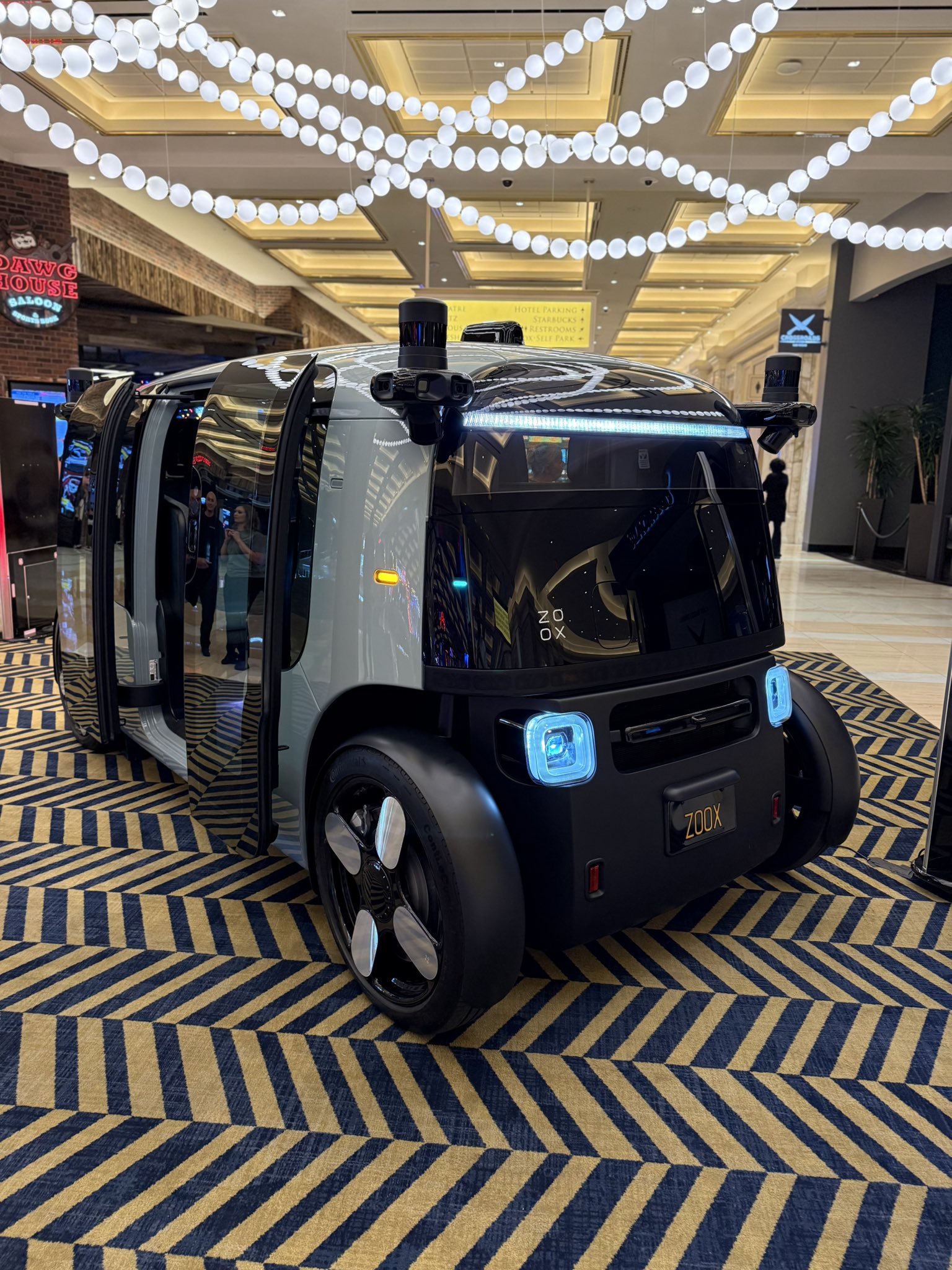
Zoox Robotaxi Facts
- Company founded: 2014 (Tim Kentley-Klay and Jesse Levinson).
- Acquired by Amazon: announced June 2020 for roughly $1.2–1.3 billion.
- Vehicle type: purpose-built, fully electric, bidirectional robotaxi with no steering wheel or pedals.
- Passenger capacity: up to 4 passengers, bench seating facing each other.
- Operational rollout: public launch in Las Vegas (September 2025) with service areas and partner pickup points; San Francisco test operations continue.
- Fleet & production: Zoox operates roughly ~50 vehicles across Las Vegas and San Francisco and opened a production facility in Hayward capable of scaling to ~10,000 vehicles/year.
Uniqueness of the Zoox Purpose-Built Robotaxi
If there is one thing that stands the Zoox robotaxi out as the real self-driving car, is its symmetrical, bidirectional pod with no front or rear distinction. Quite unlike competitors that retrofit existing cars (e.g., Waymo‘s modified Jaguars or Tesla‘s Robotaxi adapted from Tesla vehicles), Zoox’s robotaxi was built from the ground up, a resounding statement of how a futuristic, all-electric self-driving car should look like. It’s an engineering genius that sets Zoox apart from the others.
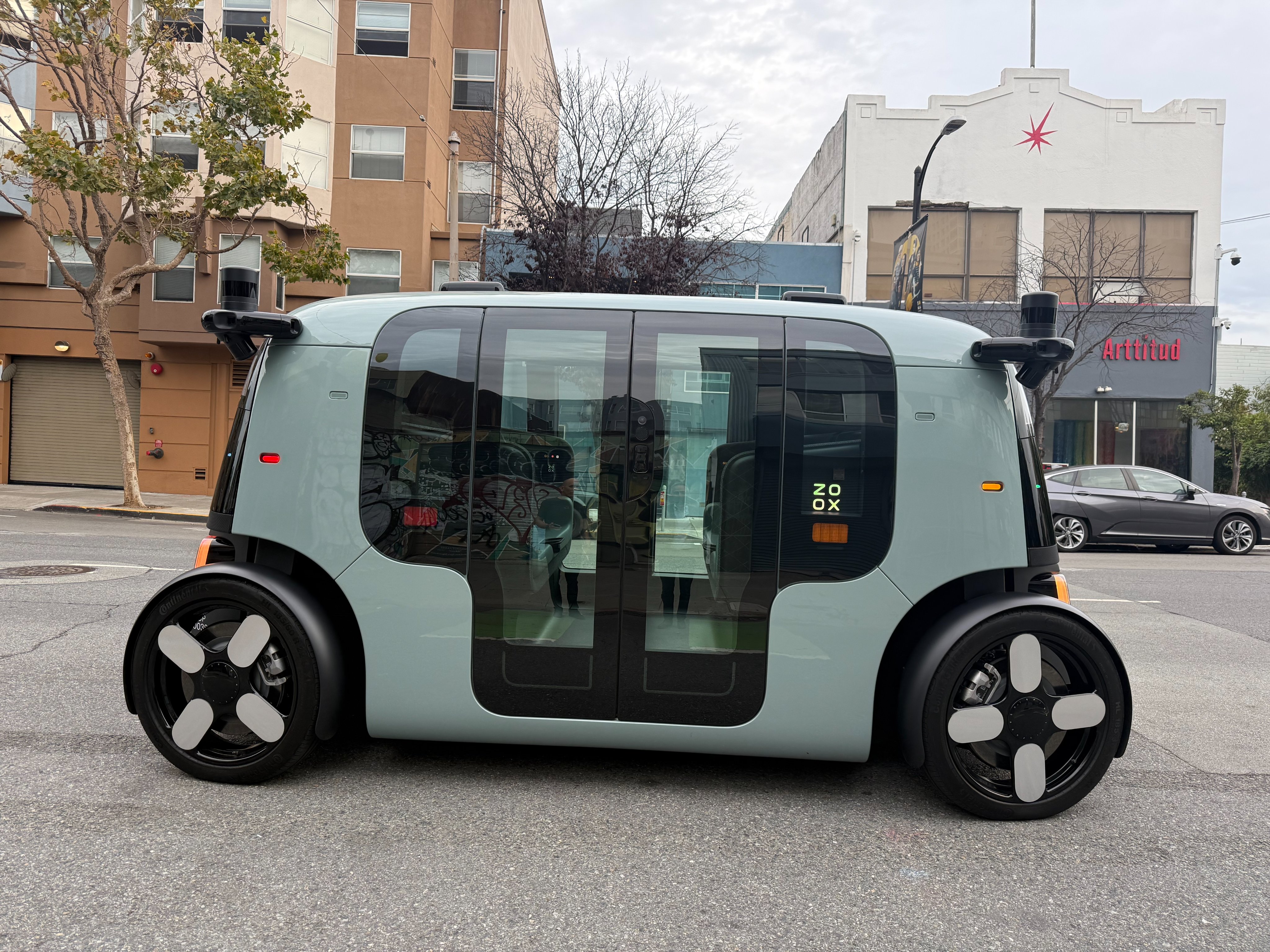
Zoox’s robotaxi core unique features include:
- Bidirectional Capability: The robotaxi can drive equally well in either direction, enhancing maneuverability in tight urban spaces.
- Carriage-Style Seating: Two rows of seats face each other, accommodating up to four passengers in a spacious, lounge-like interior without driver controls.
- Compact Footprint: At just 3.63 meters long, it has one of the smallest profiles in the industry, ideal for city navigation.
- Sensor Suite: Combines cameras, LiDAR, and radar for a 360-degree view, enabling prediction of actions from pedestrians and vehicles.
- Safety Innovations: Over 100 proprietary engineering features, including aerospace-grade redundancies, ensure reliability.
This purpose-built approach means the Zoox robotaxi is not just a self-driving car but a dedicated mobility solution. For the AV industry, it sets a new standard by promoting vertically integrated models—controlling design, manufacturing, and software. This could reduce costs, improve energy efficiency, and accelerate fleet scalability.
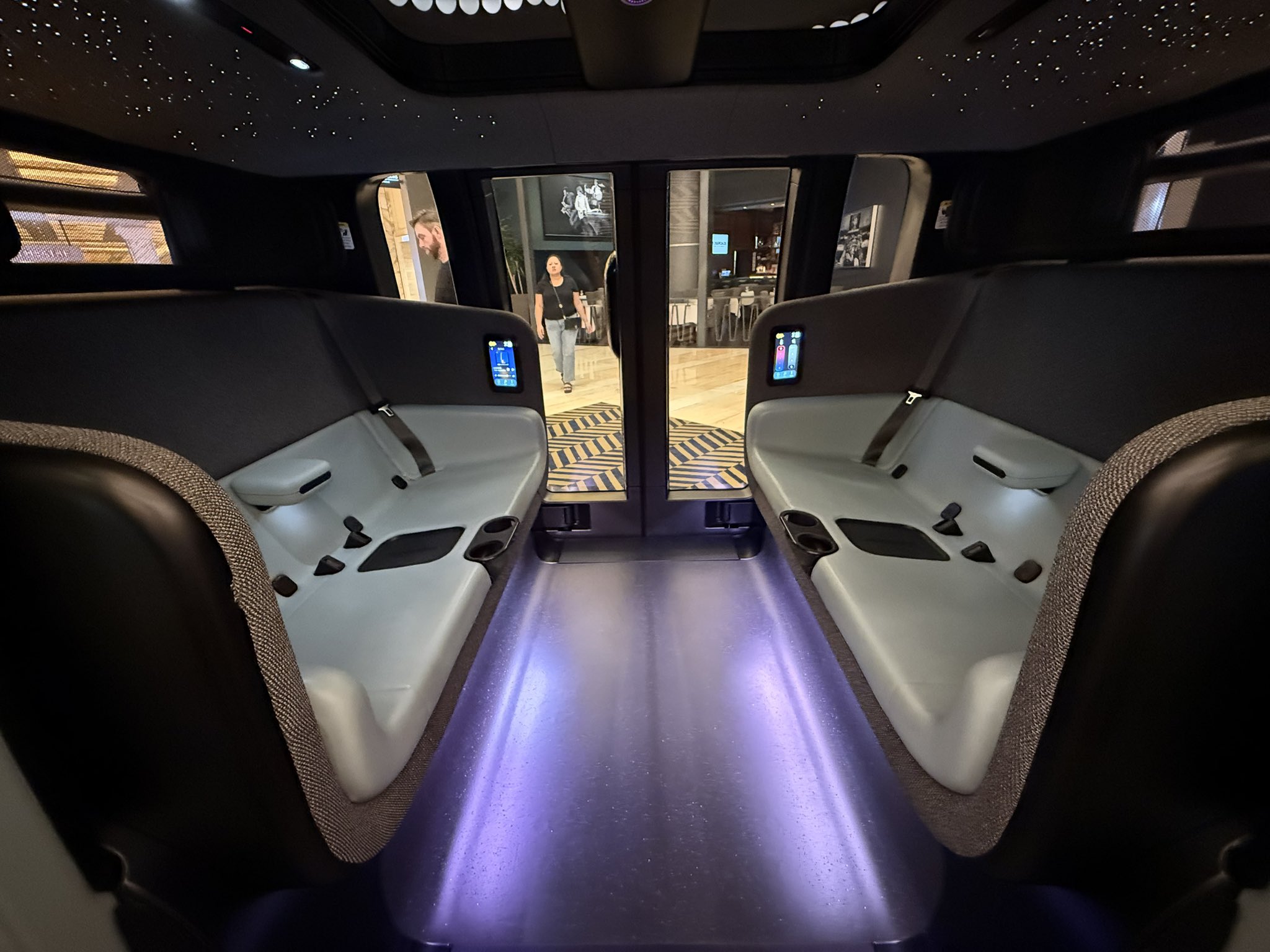
Unique Features of the Zoox Purpose-Built Robotaxi
| Feature Category | Unique Innovation | What Makes It Special |
| Bidirectional Design | Symmetrical front and back | Can drive in either direction without reversing; no traditional “front” or “back” |
| Seating Configuration | Carriage-style, face-to-face seating for 4 | Creates social space; envelops passengers for five-star crash protection |
| Airbag System | Novel bidirectional airbag configuration | Horseshoe curtain airbags, frontal, rear, side head, and seat side airbags designed specifically for carriage seating |
| Safety Redundancy | Duplicate computers and power sources | Multiple backup systems ensure operation continues if components fail |
| Sensor Architecture | 270-degree overlapping field of view | Combines cameras, radar, and LiDAR with no blind spots |
| Four-Wheel Steering | All four wheels turn independently | Combined with bidirectional capability creates incredibly tight 8.6-meter turning radius |
| Individual Climate Control | Personal climate zones for each seat | Each passenger controls their own temperature via touchscreen |
| Entertainment System | Touchscreen displays at each seat | Shows route, arrival time; passengers can select music playlists |
| Safety Interlocks | Vehicle won’t move until all seatbelts fastened | Ensures passenger safety before departure |
| Emergency Support | Help and Emergency buttons at each seat | Direct audio connection to remote Zoox support staff |
| Electric Powertrain | 133 kWh battery pack | 16-hour operational range on single charge |
| Compact Footprint | Smaller than traditional sedans | Enhanced maneuverability in tight urban environments |
| No Driver Controls | Zero steering wheels, pedals, or driver seats | Every design element optimized for passenger experience |
As Jesse Levinson, Zoox’s CTO, stated, “We’re building the future of mobility-as-a-service,” highlighting its role in making autonomous ride-hailing safer and more sustainable.
Zoox’s Key Milestones and Achievements
Zoox has achieved numerous firsts in the self-driving car sector, reinforcing its leadership in autonomous technology. Below is a timeline of major milestones:
| Year | Milestone | Details |
| 2014 | Company Founded | Started with focus on purpose-built robotaxis. |
| 2020 | Acquired by Amazon | $1.3 billion deal boosts resources for AV development. |
| 2023 | First Purpose-Built Robotaxi on Public Roads | Employee shuttle in Foster City, CA. |
| 2024 | Expanded Testing and Higher Speeds | Increased routes, hours, and top speeds in various weather conditions. |
| June 2025 | First U.S. Robotaxi Factory Opens | Hayward, CA facility targets 10,000+ vehicles/year. |
| July 2025 | Surpasses 100 Million Autonomous Miles | Validates safety and reliability. |
| Sep 2025 | Las Vegas Commercial Launch | First public robotaxi service in a purpose-built vehicle. |
| Sep 2025 | Washington DC Testing Announced | Mapping begins, with autonomous tests later in 2025. |
The Historic Las Vegas Launch
On September 10, 2025, Amazon-owned Zoox officially launched its public robotaxi service in Las Vegas, marking a pivotal moment for the company’s vision. The service is currently offering free rides to any adult, from select locations, with plans for expansion across the city.
Las Vegas is a vibrant and exciting destination that welcomes over 40 million visitors annually, and Zoox is positioned to bring autonomous ride-hailing, in its purest form, to the city.
In Las Vegas, Zoox has forged strong partnerships. They are the official robotaxi partner of Resorts World, a hospitality leader in Las Vegas, in a first of its kind agreement. Zoox is also the official autonomous ride-hail partner of AREA15 in Las Vegas, with more partnerships to be announced.
How to Book a Zoox Robotaxi Ride
- Download the Zoox app (iOS App Store/Google Play Store).
- Open the app and check “Where to Ride” — select a pickup zone listed in the app. Zoox initially limits pickups to mapped, designated zones to simplify routing and safety validation.
- Create an account and verify your age (must be 18+).
- Request a ride; the app shows wait time and vehicle info. There are in-app help buttons and in-vehicle help options to contact remote support if you need assistance.
- Select pickup and drop-off locations within the service area. The app provides real-time tracking, estimated arrival, and ride details.
- Confirm the ride—currently free, with future pricing to be announced.
- At the pickup point, follow the Zoox signage or meet an on-site concierge who will direct you to the vehicle.
You May Also Like:
6 Best Self-Driving Cars in the US (2025)
Top 5 Autonomous Trucking Companies in the US (2025)
Safety Innovations
Safety is at the core of Zoox’s design. The company has developed more than 100 safety innovations that aren’t found in conventional automobiles:
- Novel airbag system: Specifically designed for bidirectional vehicles with carriage seating
- Carriage seating that envelops passengers: Provides five-star crash safety protection
- Redundant hardware throughout: Multiple backup systems ensure continued operation if components fail
- Unique sensor architecture: Provides 270-degree field of view with overlapping coverage
- Custom AI stack: Continuously detects and mitigates potential risks
The vehicle has passed key Federal Motor Vehicle Safety Standards (FMVSS) crash tests, demonstrating that a purpose-built autonomous vehicle can meet and exceed traditional safety benchmarks.
The Zoox robotaxi is powered by NVIDIA’s advanced computing platform, making it one of the first Level 4 autonomous vehicles in commercial operation. The partnership, established in 2017, has enabled the development of a sophisticated AI system that processes vast amounts of sensor data in real-time. This comprehensive sensor architecture, combined with Zoox’s custom software stack, allows the vehicle to drive through complex urban environments, handle unexpected situations, and make split-second decisions that prioritize passenger safety.
Generative AI and Scenario Diffusion
Here’s where things get really interesting. Zoox doesn’t just test its vehicles on real roads—it also uses cutting-edge generative AI to create virtually unlimited test scenarios. The company developed a technology called Scenario Diffusion, which uses AI to generate realistic safety-critical situations that the vehicles might encounter.
It’s like a flight simulator for autonomous vehicles, but far more sophisticated. The system can create specific scenarios like a bus turning right in front of the vehicle, allowing engineers to validate how the robotaxi will respond before that situation ever occurs in real life.
Predicting Everything, Everywhere, All at Once
The beauty of Zoox’s prediction system is its comprehensiveness. It’s not just tracking the car directly in front—it’s simultaneously monitoring and predicting the behavior of every dynamic object within its sensor range.
That pedestrian three cars ahead? Tracked.
The delivery truck that might open its door? Predicted.
The cyclist approaching from a side street? Already accounted for.
This multi-agent prediction capability is what enables truly smooth rides.
Washington, DC Testing
On September 30, 2025, Zoox announced its expansion to Washington DC, marking its eighth testing site and first in the Mid-Atlantic region. Zoox is deploying test vehicles to map public streets, gathering data on local traffic patterns and infrastructure. Autonomous testing without safety drivers is slated for later in 2025, with potential public rides to follow.
It joins other players like Waymo in the capital, enhancing accessibility for residents, including those with disabilities.
Challenges and Considerations
Regulatory Hurdles
While Zoox has received approval to operate in Las Vegas, expanding to new markets will require navigating different regulatory frameworks in each city and state. The company will need to demonstrate consistent safety performance and build relationships with local authorities.
Public Acceptance
Despite impressive technology, widespread adoption of robotaxis will require building public trust. Many people remain hesitant about riding in vehicles without human drivers. Zoox’s gradual rollout with free rides and staff support at pickup locations suggests the company understands this challenge.
Operational Scalability
Operating a fleet of autonomous vehicles at scale involves challenges beyond the technology itself:
- Vehicle maintenance and cleaning
- Battery charging infrastructure
- Customer support and edge case handling
- Weather and environmental adaptations
- Emergency response protocols
Training with local emergency responders, as Zoox has done in Las Vegas, will be crucial for smooth operations.
Economic Viability
While Zoox hasn’t announced pricing, the economics of autonomous ride-hailing remain to be proven. The company will need to balance affordable pricing for passengers with sustainable unit economics. Amazon’s backing provides financial runway, but eventually, the service must demonstrate it can be profitable at scale.
Conclusion
Zoox has made a bold statement: demonstrating that fully autonomous urban transportation is transitioning from promises to reality. The Zoox robotaxis gliding down the Las Vegas Strip aren’t prototypes or experiments—they’re the beginning of a commercial service that aims to scale globally. We’re witnessing the emergence of a new form of urban mobility that could reshape how cities function, how we think about car ownership, and how we move through our daily lives.
If you find yourself in Las Vegas, download the Zoox app, request a ride, and step into the future of urban transportation.
Also Read:
10 Mind-Blowing Things to Know About Zoox
Understanding Agentic AI in Autonomous Vehicles: A Tensor Robocar Case Study

I’m Dr. Brandial Bright, also known as the AVangelist. As a dedicated and passionate researcher in autonomous and electric vehicles (AVs and EVs), my mission is to educate and raise awareness within the automotive industry. As the Founder and Managing Partner of Fifth Level Consulting, I promote the adoption and innovation of advanced vehicle technologies through speaking engagements, consulting, and research as we progress to level 5 fully autonomous vehicles.

